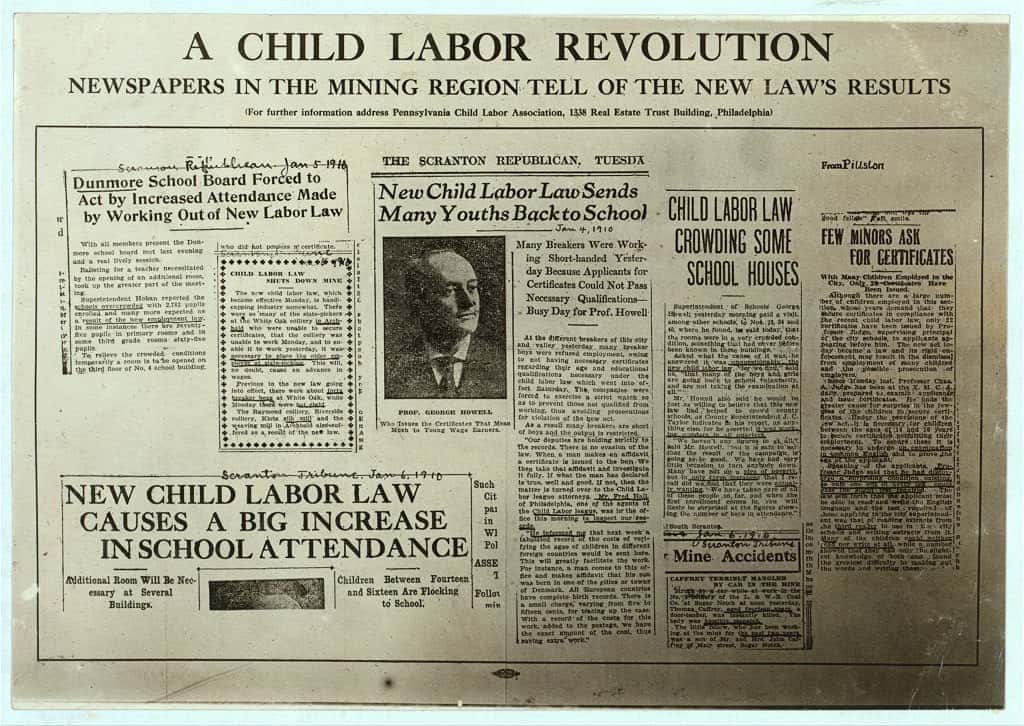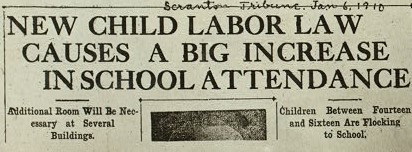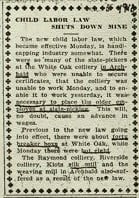Featured image by The New York Public Library.
As industrialization in the United States increased following the Civil War, it was common to find American children working outside of the home to earn wages for themselves or their families. Children worked in many different industries and represented much of the labor force. It was not until the 1930s that Child Labor laws would be enacted to protect the rights of young children in the US.
The Breaker Boys

The boys in the photo above are one example of popular employment for youth. These “breaker boys” spent their days sitting along a conveyor belt, “breaking” away the impurities within the coal atop the belt. Working within a coal mine was often dangerous and attributed to poor health of the workers.
What do you think it was like to work as a “breaker boy”?
Child Labor Standards

Beginning in the 1900s, groups of people started advocating for an end to child labor. Eventually, the Children’s Bureau enacted the Fair Labor Standards Act, making it illegal for children under the age of 16 to work full time.
What do you think drove the Children’s Bureau to make this decision?

Unexpected Impacts

What can these newspaper articles tell us about some of the outcomes of this decision?
Discussion Questions:
1. How has the United States coped with these impacts?
2. How has the United States evolved since this time?
3. What changes, if any, have been made to the child labor laws?






Really dig those newspaper headlines and articles. Great mix of mediums on this post with the pictures, advertisement by the U.S. Dept. of Labor, and the newspaper articles. It really helps the reader to get a full grasp on the topic. I never realized schools became over crowded as a result of the child labor laws past at the time, makes perfect sense though. Some clarification of specific dates might be helpful; you state in the beginning of the post that it wasn’t until the 1930s that child labor laws were passed, but all of the articles at the end of the post are from the 1910s. Maybe different age limits and standards were enacted at different times? None the less, great post!
Madi, the choice of featured image and breaker boys really set the tone for this theme of child labor laws. I think Kyle makes a good point that makes a case for changing the presentation order of the 2nd and 3rd image.
Your topic, images and close looks remind us of how “recently” children were exploited for cheap labor in the US and how that practice continues in other countries of the world.
Thanks for pointing that out, Kyle! To my understanding, child labor laws prior to the 1930s were enacted by state governments. I think this is where the differences in dates come from. I definitely think I could clarify my writing to make this post stronger. Thanks again!
I think this a great way to think the past to the present. Young students to this will be able to 1) more fully understand the practice of child labor in the United States and 2) connect their own lives to those that experienced the practice of child labor. When you see people like you (in this case other children) in a situation I think you can empathize with their plight more.
I agree, Bruce. It’s one thing to read or hear about a topic, but seeing pictures of it hits differently. I saw many photos of child laborers while searching for the images I chose, and it’s somewhat surreal to know that children as young as 10 (though sometimes younger) worked as much and in the same conditions as adults. I couldn’t imagine my middle schoolers working in a mine!
Madi! Fantastic topic, that coal mine photo is so haunting. I agree with Bruce that kids learning about the child labor laws would be more impactful because they can see themselves in the subject matter. I also think your discussion questions are fantastic, there’s a ton to explore about how child labor laws impacted education in the US.
Thanks, Olivia! I would love to explore this topic more in my own classroom someday because of how easy it could be for students to relate. I think it would be interesting to see middle schoolers thoughts on what it would be like to work instead of go to school.
Great topic, Madi! I like that there’s a topic on here directly related to kids. Oftentimes when you’re going through history courses at school, the history is focused on adults. Since most students have not experienced adult life, it could be less relatable. It’s a bit different than asking, “Hey kids, can you imagine working 10 hours shifts in the coal mines at your age?” I would imagine it’d just resonate with students a bit more since they can relate to being a child still. Very cool!